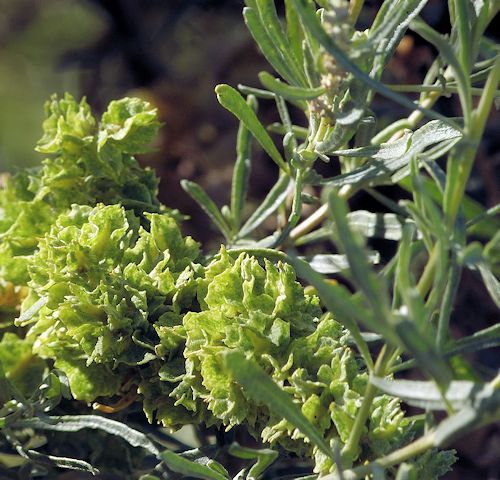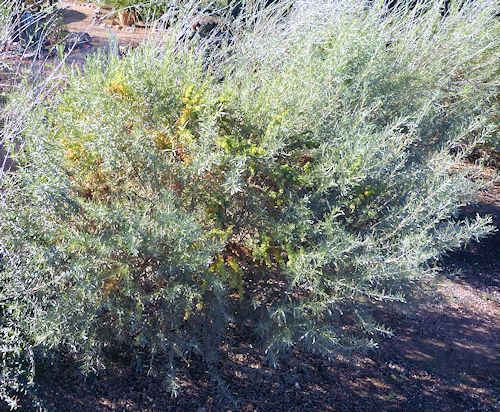Growing Atriplex canescens:
Fourwing Saltbush
Description
Form: A nondescript shrub with a highly variable shape.
Leaf retention: Evergreen but drought deciduous.
Growth rate: Moderate.
Mature Size: 5' (1.5m) high and 8' (2.4m) wide.
Flowers: The tiny, clustered, green male flowers and tiny, yellow female flowers are found on separate plants, but the plant can change sex after an unusually cold, dry, or heavy-bearing year.
Bloom: Spring to summer.
Fruit: Showy clusters of brown, four-winged seeds on female plants in the fall.
Leaves: Small, gray-green, linear. The leaves contain specialized salt bladders that concentrate salt. The plant rids itself of salt by shedding its leaves during extreme drought.
Stems: Stiff, hairy when young aging to smooth, thin bark.
Roots: Wide and deep, with a taproot.
Wildlife: The flowers attract bees and butterflies. Fourwing Saltbush is also a caterpillar food plant for various species of butterflies. This plant also attracts lacewings and ladybugs which feed on the scale insects and mealybugs which may attack the plant. The seed attracts birds. The foliage is browsed by mammals, so the plant must be caged until it is 4' (1.2m) high.
Toxic / Danger: This plant may accumulate minerals such as selenium from the soil in its leaves and become toxic to livestock. In normal soils, the plant is good fodder. The pollen often causes hay fever.
Origin: Western North America.
Form: A nondescript shrub with a highly variable shape.
Leaf retention: Evergreen but drought deciduous.
Growth rate: Moderate.
Mature Size: 5' (1.5m) high and 8' (2.4m) wide.
Flowers: The tiny, clustered, green male flowers and tiny, yellow female flowers are found on separate plants, but the plant can change sex after an unusually cold, dry, or heavy-bearing year.
Bloom: Spring to summer.
Fruit: Showy clusters of brown, four-winged seeds on female plants in the fall.
Leaves: Small, gray-green, linear. The leaves contain specialized salt bladders that concentrate salt. The plant rids itself of salt by shedding its leaves during extreme drought.
Stems: Stiff, hairy when young aging to smooth, thin bark.
Roots: Wide and deep, with a taproot.
Wildlife: The flowers attract bees and butterflies. Fourwing Saltbush is also a caterpillar food plant for various species of butterflies. This plant also attracts lacewings and ladybugs which feed on the scale insects and mealybugs which may attack the plant. The seed attracts birds. The foliage is browsed by mammals, so the plant must be caged until it is 4' (1.2m) high.
Toxic / Danger: This plant may accumulate minerals such as selenium from the soil in its leaves and become toxic to livestock. In normal soils, the plant is good fodder. The pollen often causes hay fever.
Origin: Western North America.
Cultivation and Uses
USDA hardiness zones: 3-11.
Heat tolerant: Yes.
Drought tolerant: Yes.
Sun: Full sun to part shade.
Soil: Dry, pH 6.6-9.0 (neutral to highly alkaline). This plant is tolerant of arid western soils including those laden with salt. Moderate to high salinity levels in the soil improve this plant's growth rate and its ability to photosynthesize.
Water once established: Monthly during drought.
Prune: In late winter, prune to shape or cut back by one-third to re-invigorate. This plant can be pruned into a hedge.
Litter: Low.
Propagation: Seed, stored for a year, outer wings removed, and soaked.
Uses: Erosion control, bird garden. The seeds are edible and were ground into a meal by native Americans.
USDA hardiness zones: 3-11.
Heat tolerant: Yes.
Drought tolerant: Yes.
Sun: Full sun to part shade.
Soil: Dry, pH 6.6-9.0 (neutral to highly alkaline). This plant is tolerant of arid western soils including those laden with salt. Moderate to high salinity levels in the soil improve this plant's growth rate and its ability to photosynthesize.
Water once established: Monthly during drought.
Prune: In late winter, prune to shape or cut back by one-third to re-invigorate. This plant can be pruned into a hedge.
Litter: Low.
Propagation: Seed, stored for a year, outer wings removed, and soaked.
Uses: Erosion control, bird garden. The seeds are edible and were ground into a meal by native Americans.
Comments
This plant is a member of the Amaranth family (Amaranthaceae). Another common name is Saltbush. This is one of the most rapidly evolving plants in North America due to cross-breeding with related species. It is an excellent desert wildlife shrub, is fire resistant, and can grow where most other plants cannot.
Do you have additional information or a different experience for these plants that you would like to share? Email info@GardenOracle.com. All contributions are welcome and appreciated.
This plant is a member of the Amaranth family (Amaranthaceae). Another common name is Saltbush. This is one of the most rapidly evolving plants in North America due to cross-breeding with related species. It is an excellent desert wildlife shrub, is fire resistant, and can grow where most other plants cannot.
Do you have additional information or a different experience for these plants that you would like to share? Email info@GardenOracle.com. All contributions are welcome and appreciated.

The immature, four-winged seeds are light green.


The light green clustered seeds are visible among the foliage.
Latest update: October, 2024
© 2008-2025 by GardenOracle.com

